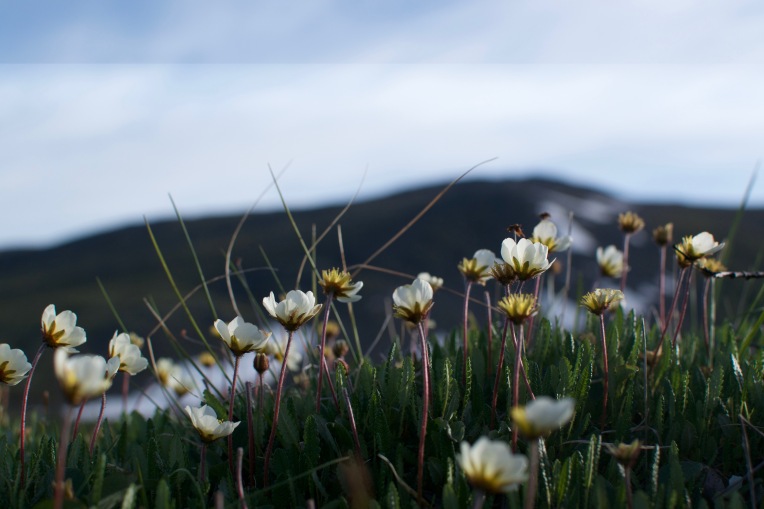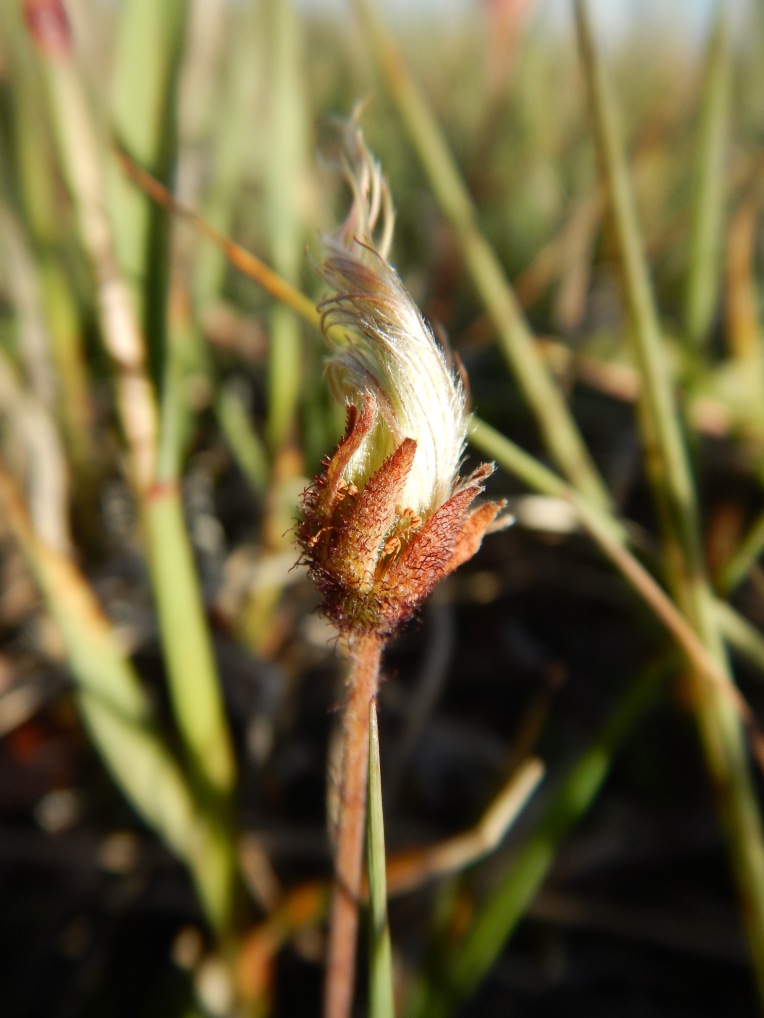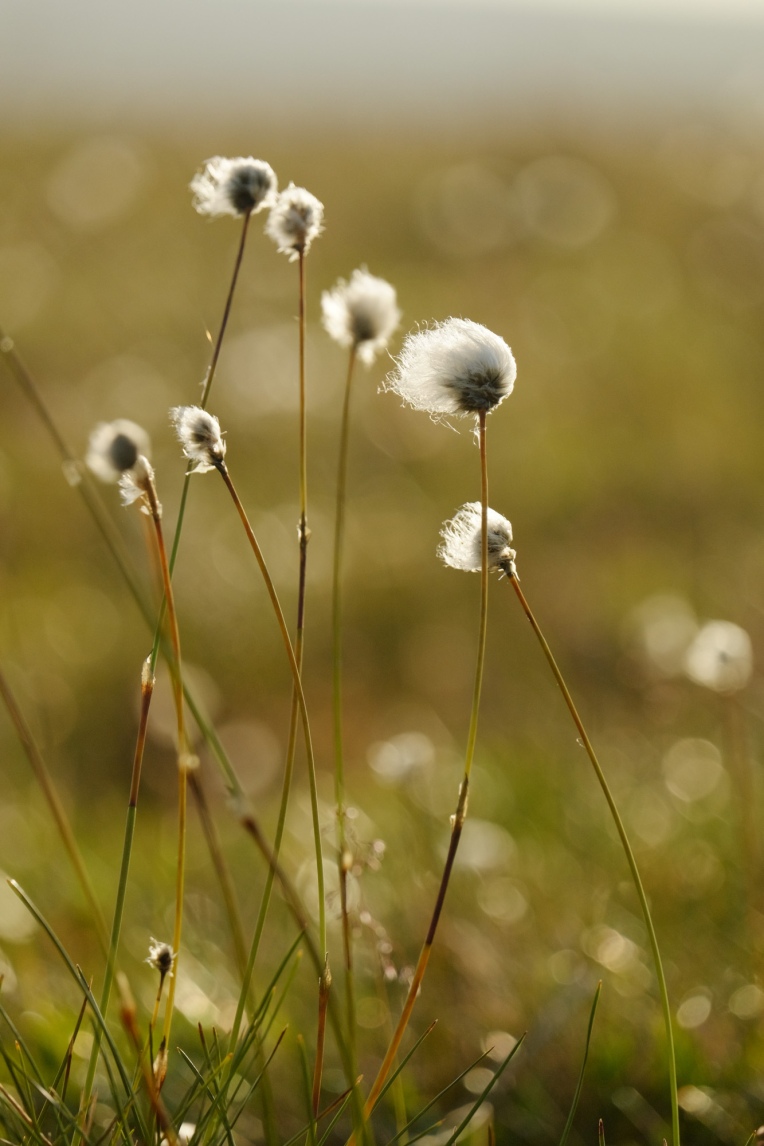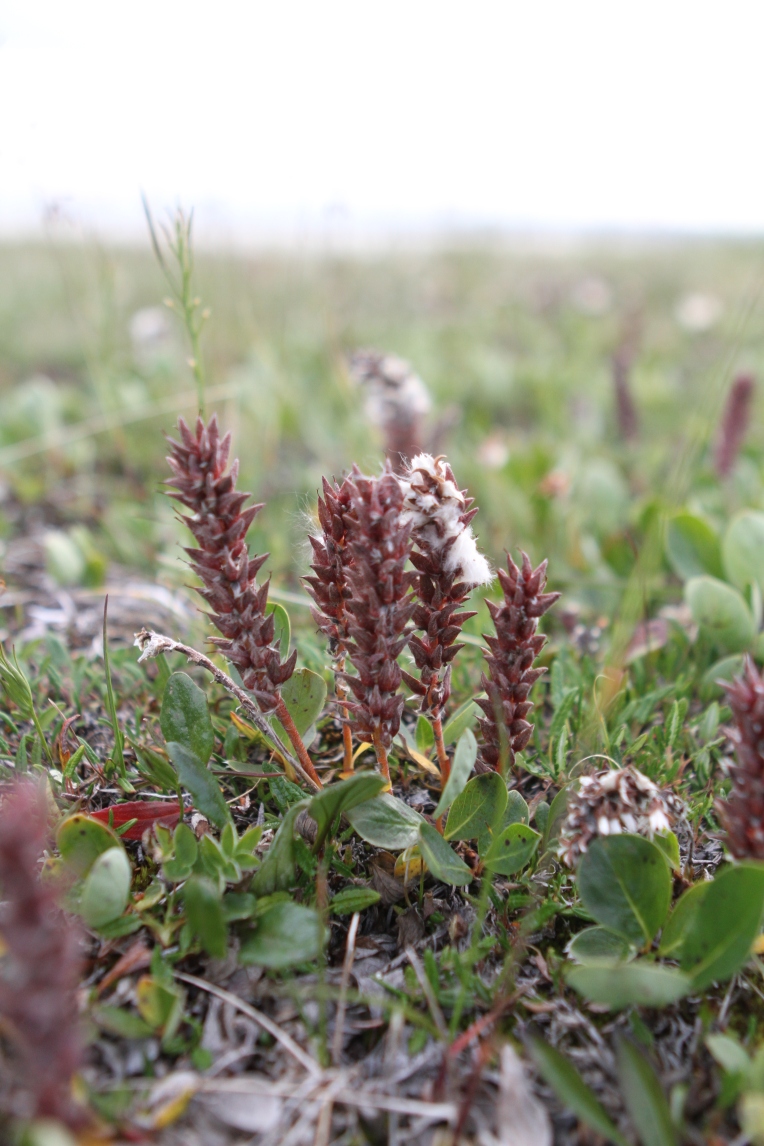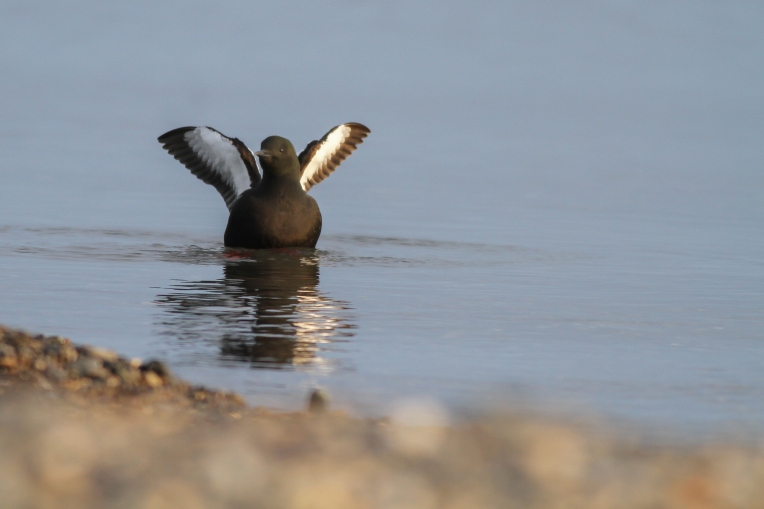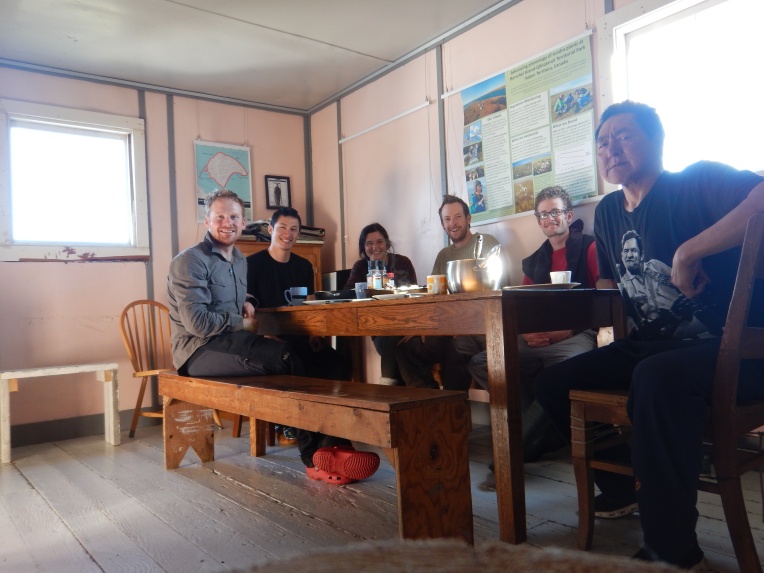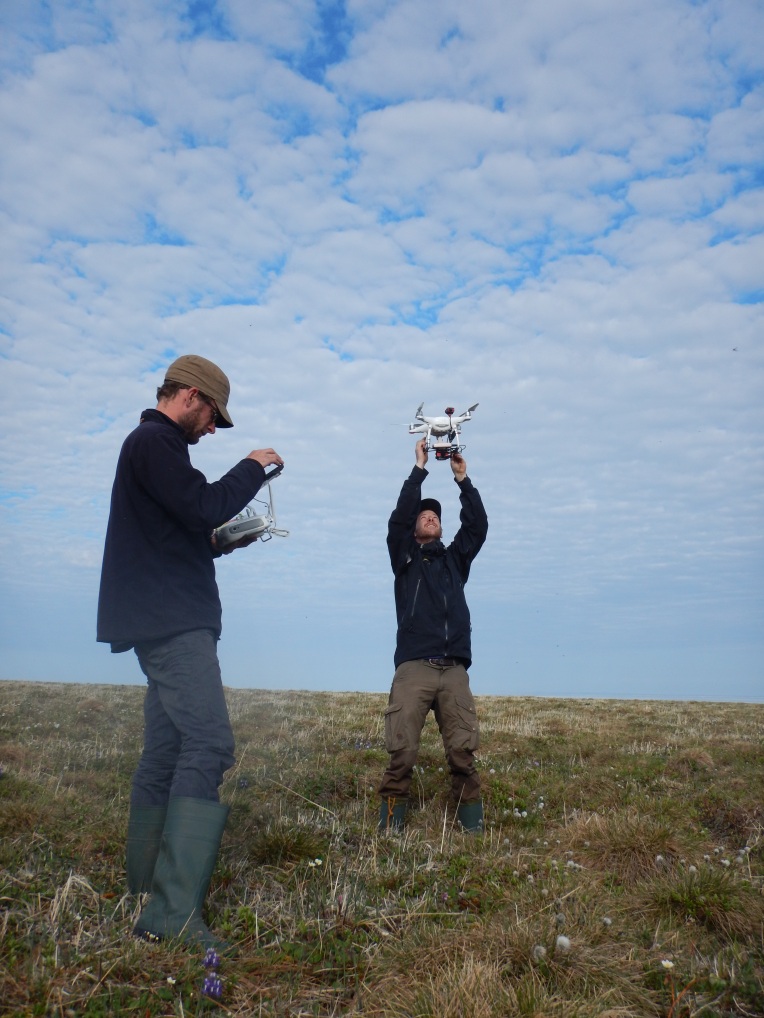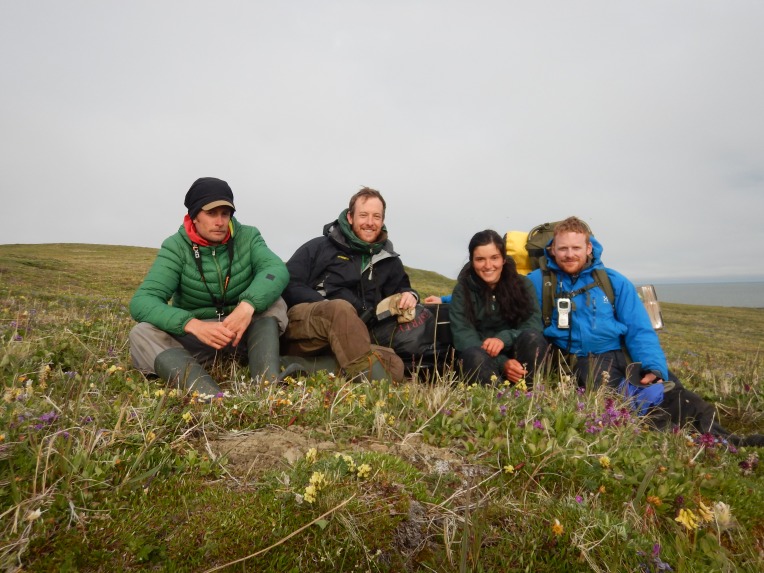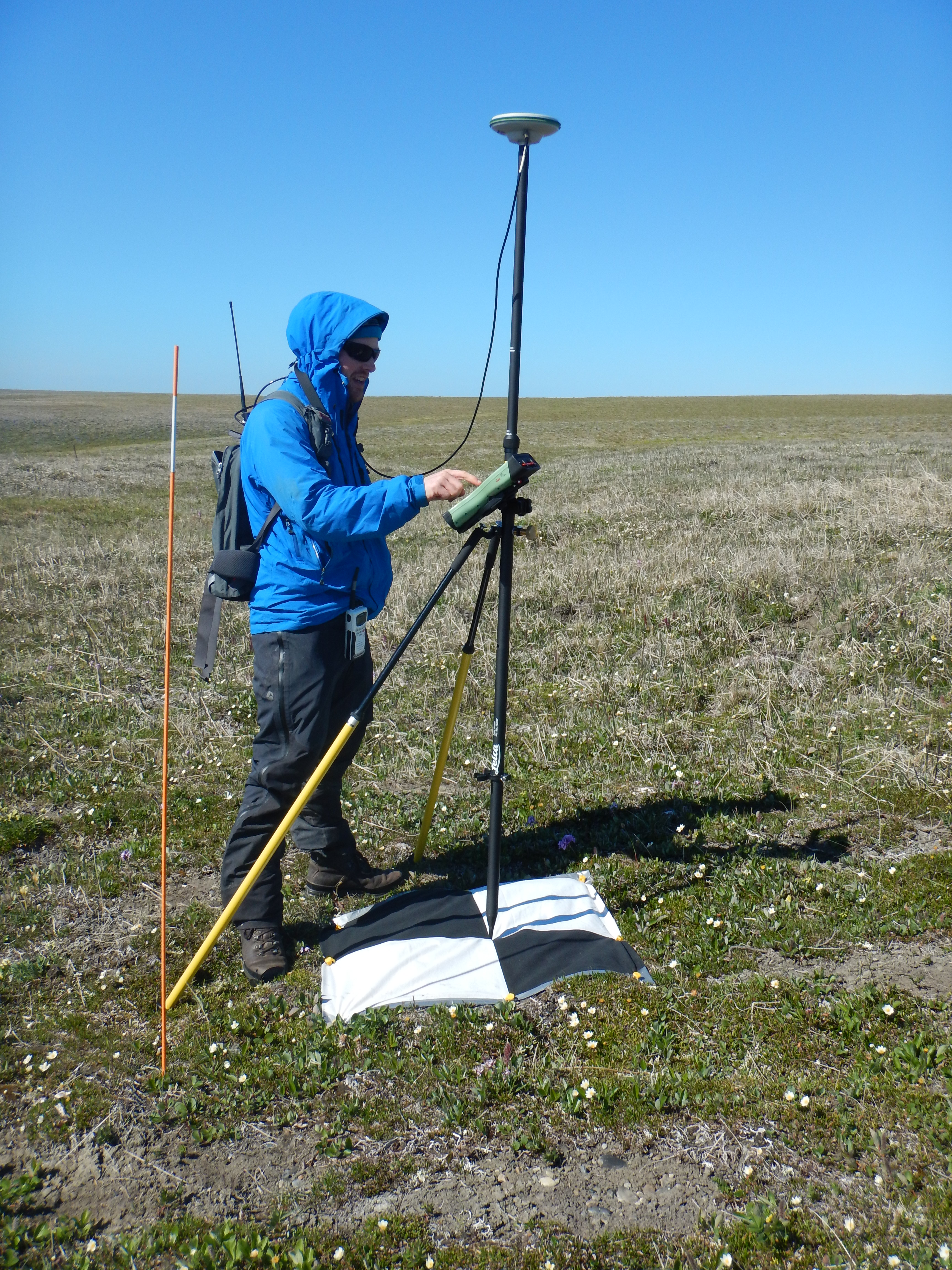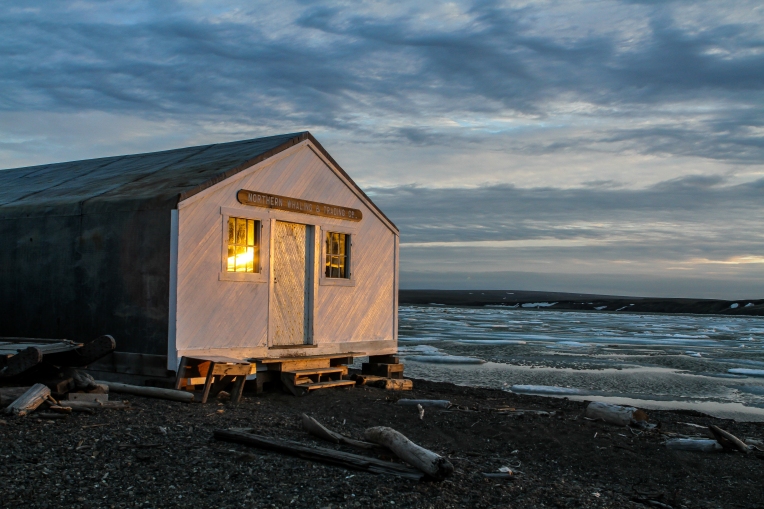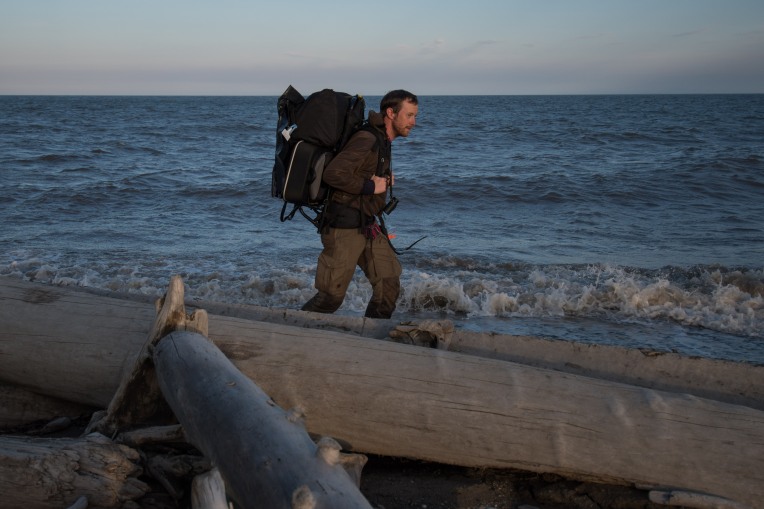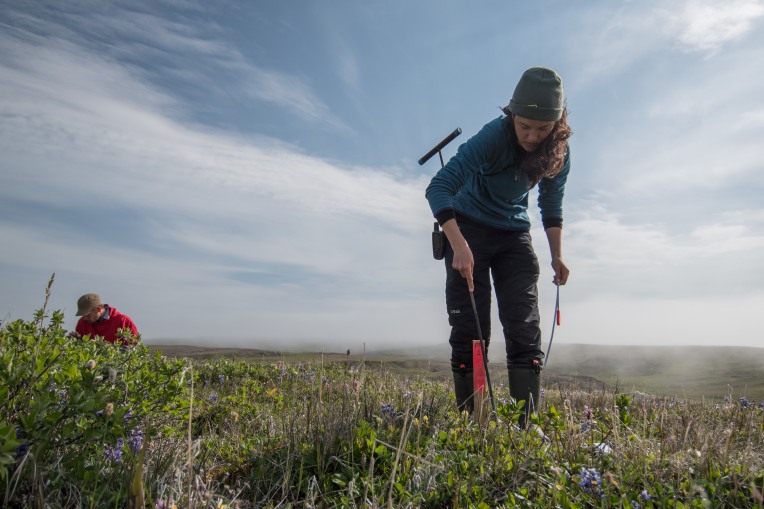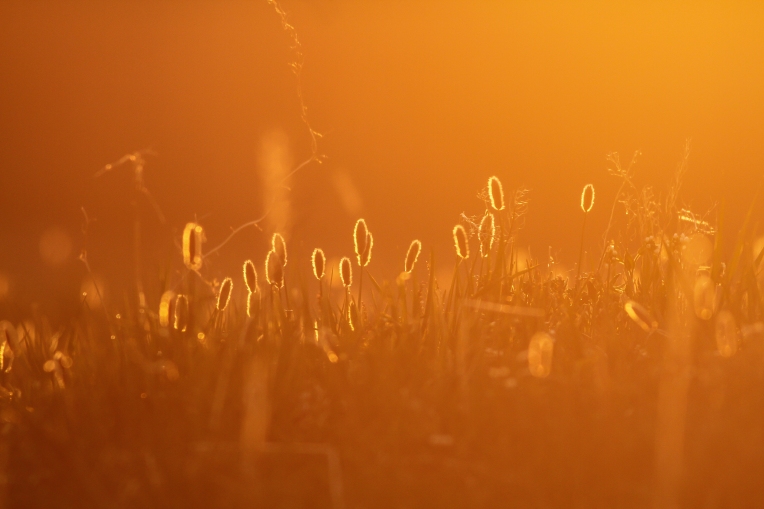On a cold and distant island the stars of our science are sleeping. Buried under a thick winter blanket, Qikiqtaruk in winter is exactly what many people imagine when I say I work in the Arctic: awash with snowdrifts, locked in sea ice, home for polar bears and not a huge amount else.

Yet here on Team Shrub we study plants. Come the summer sun, green tendrils of life emerge from the snow and the hardy, beautiful and fascinating plant life of the tundra begins to grow. Diverse in the manner of tropical rainforests it may not be, but these cold lands are nonetheless brimming with more life than you might think, featuring old favourites that adorn the hills of Scotland to wacky monstrosities that seem to spring out of some primeval past.
In this series we will be exploring some of our favourite species from our most northern field site, starting with our namesake: the shrubs.
The Shrubs
What makes a shrub? Such has been the dinnertime conversation at many a Scottish Feast. In short: short. Woody. Multi-stemmed. Sometimes evergreen, sometimes deciduous, always beautiful.
The willows
Qikiqtaruk is home to a grand total of nine willow species. Not bad for an isolated Arctic island. The Salix genus dominates much of the upper shin-high canopy, though you can find yourself wading through some of the bigger fellows. Bjorn even reaches chest height. Deciduous, green-leaved, the willows add a certain magic to the tundra as their fluffy seed spirals in the air on a breezy day, while bright red catkins dot the tundra floor underfoot.
Salix pulchra
Possibly our favourite shrub on the island. This beautiful willow surely lives up to its name: long ruby stems and startling emerald-bright diamond leaves, giving Salix pulchra its common name, diamond-leaf willow. On Qikiqtaruk Salix pulchra grows mostly along the ground in large, clonal mats that creep between tussocks of cottongrass and shelter small white Stellaria flowers. It’s one to watch though, as further south this willow can reach well over head height. Here, where the weather is sheltered and nutrients seep from the permafrost, Salix pulchra grows faster, bigger, redder, standing out from its neighbours atop the palsas, while on the hilltops we have already seen a tripling in its canopy height since we first started recording in 1999.

Salix richardsonii
One of the giants of Qikiqtaruk, Salix richardsonii, or Richardson’s willow, is the most common tall shrub on the island. It grows mostly in wetter, sheltered areas such as river floodplains, where nutrients flow freely and life is as easy as it gets in this bastion of land in the Arctic ocean. Forming a dense, shrubby canopy of bright green leaves, Salix richardsonii nonetheless has a rather grizzled visage, giving it our nickname ‘Old Man Willow’. Twisted branches and flaking orange-brown bark, flecked with white specks of age or hardship. Fat, hairy stipules easily mark it apart from other willows. A canopy bully, Salix richardsonii is now dominating areas where it can grow, rapidly expanding in many parts of the island as the climate warms.

Salix arctica
This small willow is a remarkable example of the success and resilience of plants in these cold lands. Salix arctica, the Arctic willow, has the most northernmost geographic range of any woody plant, reaching all the way to the north coast of Greenland at 83 degrees north. A ground-hugging, prostrate woody shrub, it spreads woody limbs akimbo, stretching out in all directions along the top of the permafrost. Thin stems become roots, become stems again and it advances clonally, covering much of the surface until it is impossible to tell where one plant begins and another ends. Even if the main “trunk” is destroyed or decays, the plant will not die: an attempt at immortality. Unlike many of the other dwarf willows, Salix arctica eschews the small leaves and catkins of its fellow family members, and sticks to the strategy of the taller shrubs that bigger is better. Big, fat leaves emerge from the brittle stems, which giant fluffy catkins can strike up from the ground surface several times taller than the rest of the plant. Unusually, on Qikiqtaruk even the leaves and stems of Salix arctica strike upwards for the sky, possibly a hybridisation of one kind or another, and can stretch up even as much as 20cm from the soil.

Salix reticulata
Just like Salix arctica, this dwarf willow hugs the floor with brittle stems and clonal creeping growth in all directions. The thick, leathery leaves of this plant give it its common name: net-leaved willow, which are criss-crossed and pocked with deep grooves. Once fallen in winter, these hardy leaves last, resisting decomposition and creating a crunching carpet underfoot.

Salix polaris and Salix phlebophylla
The smallest of Qikiqtaruk’s willows, these two species take you down onto hands and knees to appreciate their tiny round leaves and stalk-like stems. Hugging the ground in dense mats, often on the drier sections of hillsides or edges of tussocks, I often have trouble telling these apart from leaves alone. Yet catch them right in the season, and the red catkins of the polar willow (Salix polaris) stand out as one of the brightest flashes of red on the tundra, flecks of delicate colour, blood-rich, that in a matter of days dissolve into white and wind.
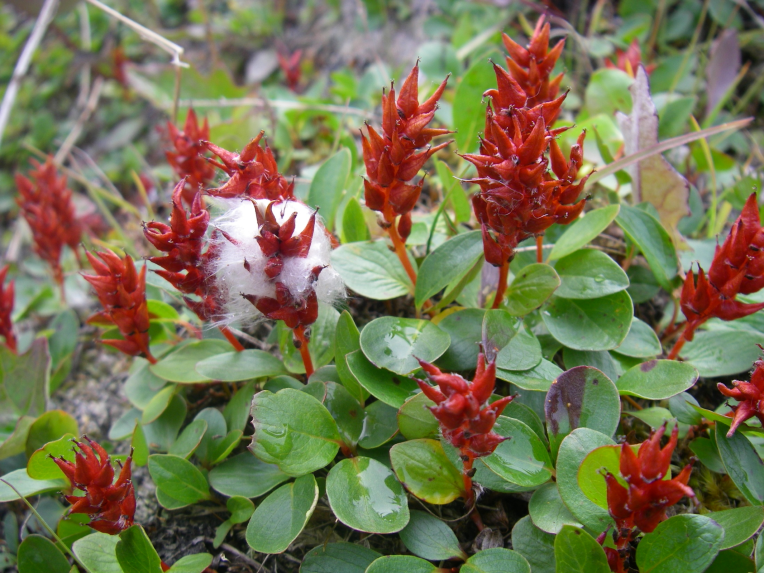
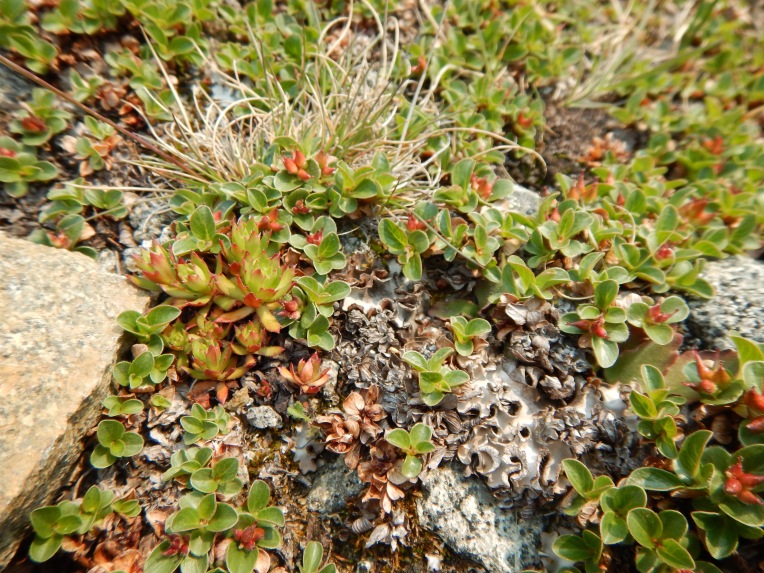
Salix glauca and Salix niphoclada
Two of the rarer tall shrubs on Qikiqtaruk, grey willow (Salix glauca) and snow willow (Salix niphoclada) can be a challenge to find, but occasionally stand out on the hillside where some seed has found its way to establishing. The grey-tinged haze of glauca willows sets them apart from the rest, while the sometimes rose-tinged stems and somewhat brighter leaves of niphoclada can cause us headaches when we search for Salix pulchra to sample. These two willows with green leaves covered in fine grey hairs and stems with a blue-green and waxy look to them can be indistinguishable when they have no visible catkins, which is much of the time, so they are often clumped together in our analyses.

Salix alaxensis
Finally, the Goliath of Arctic willows. Salix alaxensis grows tall and often somewhat spindly up on Qikiqtaruk, almost buddleia-like, as if it wants to reach the sun and doesn’t care how it gets there. The leaves are grey-green, but a bright, fluffy white underneath – lannate, densely villous or tomentose if you will. Did you know there are over 20 botanical terms for being hairy! Certainly easy to identify. We have only recently discovered Salix alaxensis, the Alaskan willow, on Qikiqtaruk, though since individuals are already well established, thus it must have been evading detection for many decades.
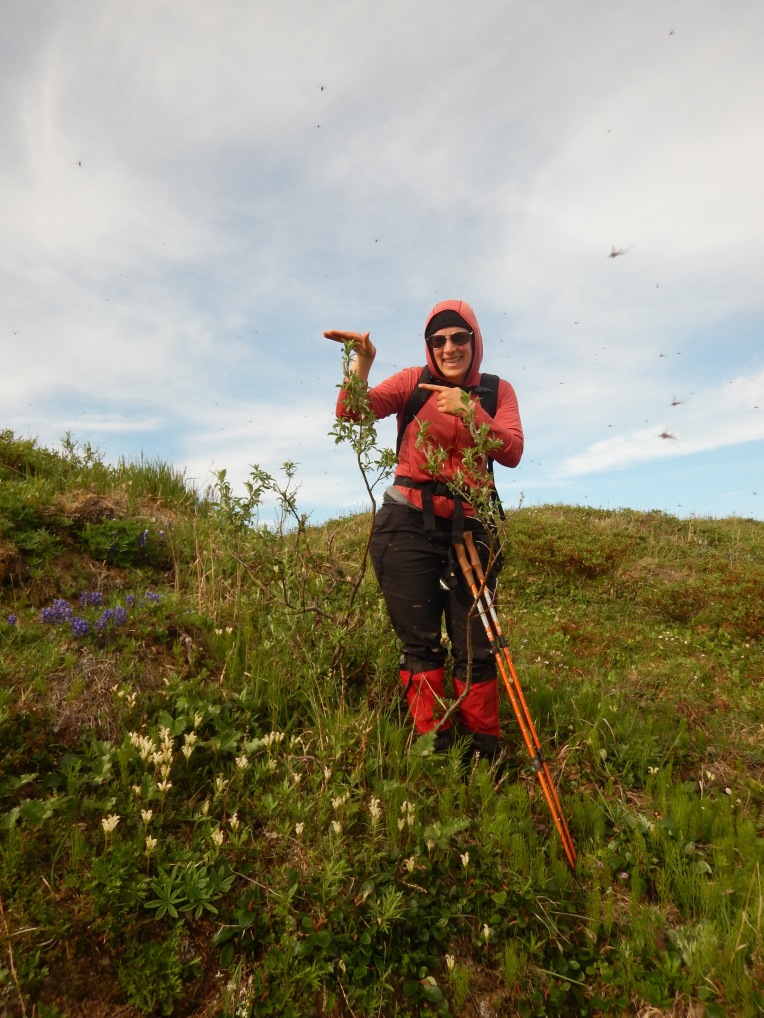
The birches
Betula nana and Betula glandulosa
If you spend much of your time tramping about the high hilltops of Scotland you may already be familiar with dwarf birch. Small, thickety and brittle, the dense brown stems of Betula nana or Betula glandulosa have snagged many a bootlace and tripped many a toe. Still, I love the Betulas for their leaves alone, some of the most perfect forms on the tundra. On Qikiqtaruk, Betula nana holds sway on flatter patches of hilltop; a low growing shrub that announces its presence as a darker green blur on the landscape, or from the waft of crushed Labrador tea underfoot, which tends to grow alongside birch. Unlike many other tundra sites, where Betula has run rampant as the climate warms, it so far seems to be losing out to the willows here, though in some places the dense, spotted branches form an impenetrable tangle across whole swathes of tundra. As for the difference between nana and glandulosa, the latter is taller, larger leaved, greater noduled. Or not, as the case may be – perhaps they are one species after all, marked apart not by genetics but simply variation.

Tundra tea
Rhododendron tomentosum
A hero of the Arctic smellscape, Rhododendron tomentosum is another favourite of ours. The shrub itself is part beautiful: white flowering baubles full of rich scent, rusted felt underside of leaves, and part ugly: the ash-black branches spindly, frail and commonly dead, dark leaves often matted and speckled, a formless shape creeping amongst better rivals. But altogether outstanding are the leaves themselves. Rhododendron tomentosum, marsh Labrador tea, may not quite have the glamour of its more grandiose and much less marshy southern cousin, but its leaves still bear the scent of a thousand tundra days; that unmistakable and uncapturable spice of terpene and midnight chlorophyll. This is a shrub that makes trait work bearable, and often one that prompts a pocket full of leaves for the walk home.
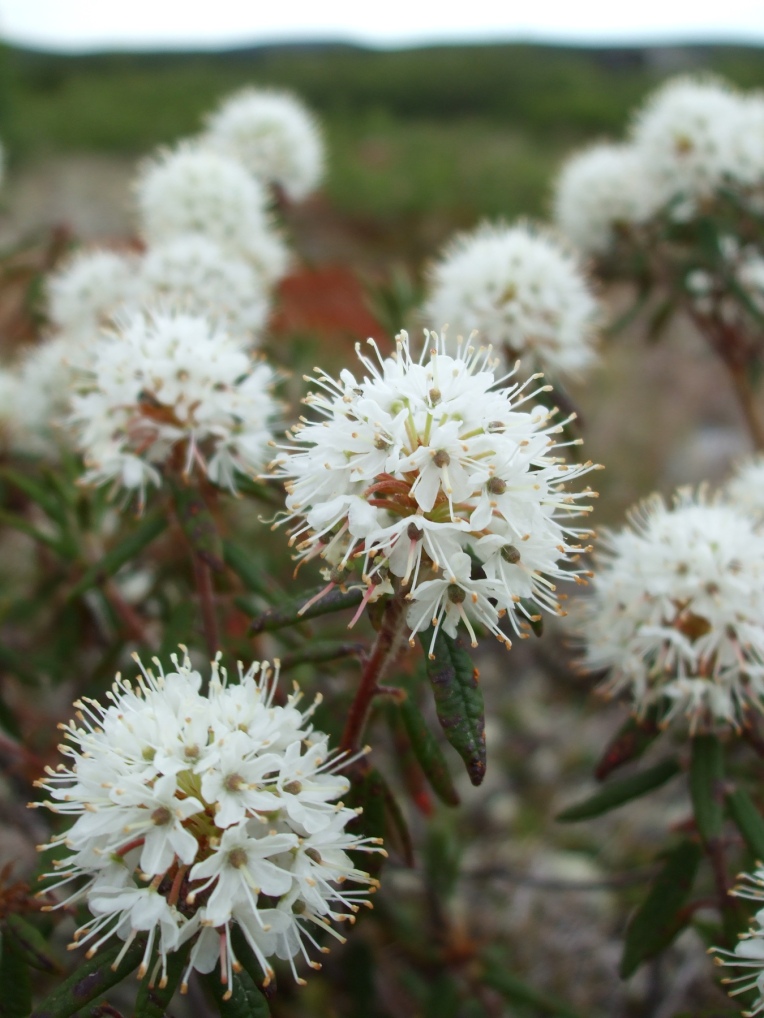
The berry bearers
Arctostaphylos rubra (Arctous rubra)
One for the photo albums. A. rubra, or bearberry, is certainly one of the more iconic tundra shrubs due to its bright, Rudolph-red leaves that can stain the bare tundra at certain times of year. Another prostrate-growing shrub, the ovate, vein-y leaves can bear a resemblance to the leather coins of Salix reticulata when green, though are stretched and less waxy. It is when the winter begins to draw in that Arctostaphylos rubra sets itself apart as the leaves turn, and formerly invisible patches of bearberry shine out. Red too, the berries that hide in amongst the leaves: a food source for humans and wildlife alike, though their diuretic properties also lend themselves to herbal medicines and may explain the preponderance of stained bear poo littering the tundra in autumn. A closely related species, Arctous alpina, looks almost identical except for the red berries that turn black when ripe.
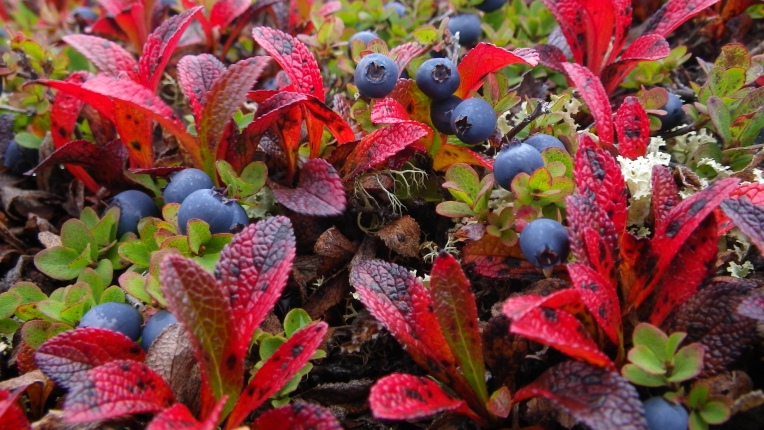
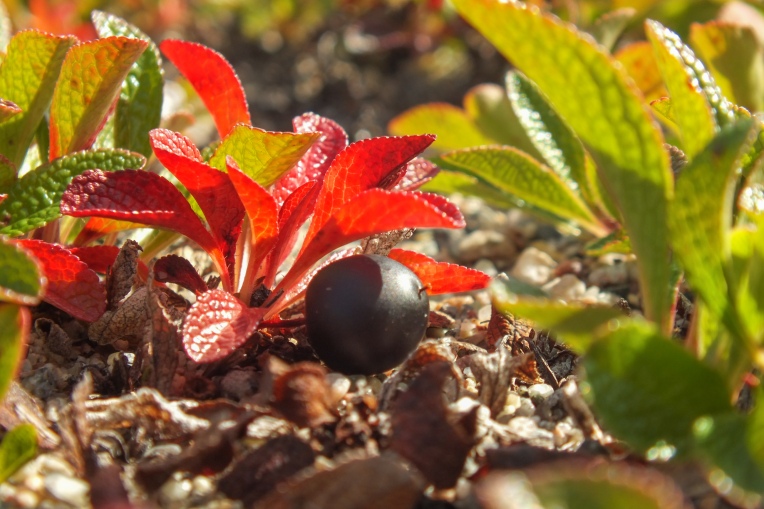
Vaccinium vitis-idea and Vaccinium uliginosum
Another set of plants that will be well known to hillwalkers, the Vaccinium genus is the main fruit bearer for local people and hungry researchers. The smallest, Vaccinium vitis-idea (Ligonberry, cranberry, cowberry – you name it!), carpets the surface with tiny, glossy leaves and even glossier red berries where cover is sparse and soils fairly dry. In places the leaves can turn to a deep, merlot red, or still drip with pink-white cowbell flowers. Harder to find on Qikiqtaruk, Vaccinium uliginosum (blueberry, bilberry etc.) rise higher from the undergrowth where soils are wetter, their berries blue, stems tough brown-green and leaves thinner and more leathery.
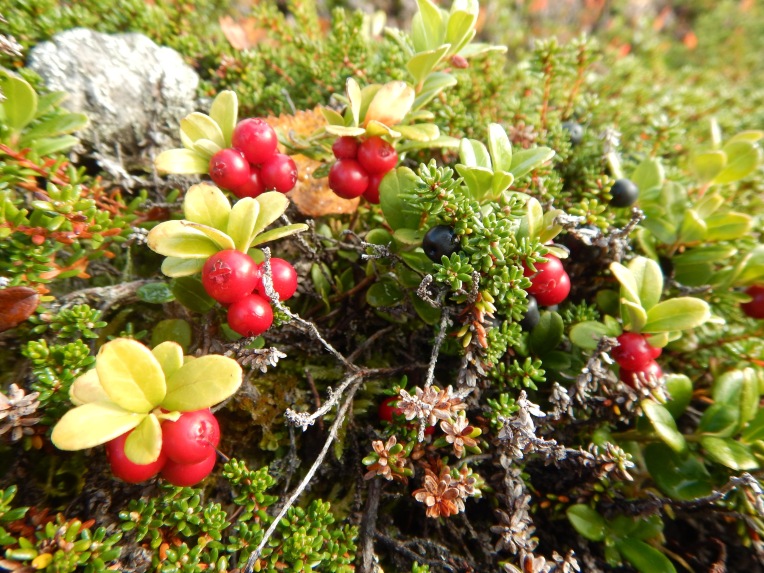
Rubus chamaemorus
Cloudberry, baked apple, or knotberry in England and averin in Scotland is best known on Qikiqtaruk as aqpik. This is one of the most prized of berries in this part of the world and when perfectly ripe is a delicious topping to pancakes, makes an excellent jam or is the perfect snack when stopping across the tundra. Quick to turn from unripe to rotten, finding your patch of cloudberries in season on Qikiqtaruk can be a challenge. It is rare out there, preferring the wetter habitats on the edges of ponds or in ice-wedge terrain.

Empetrum nigrum
A heathery-looking dwarf shrub that is equally at home in the Scottish Highlands, on mountaintops around the northern hemisphere, under conifer canopies of the boreal forest, and in vast swathes of tundra. Also a clonal shrub, Empetrum nigrum can form dense mats stretching uninterruptedly for meters, or even tens of meters. Its super-power is allelopathy: the leaves contain toxic chemicals which, when leached into the ground after the rain, hinder germination or growth of other plant species. Fun fact: the wood smells delicious when boiled in water (don’t ask, and probably don’t drink).
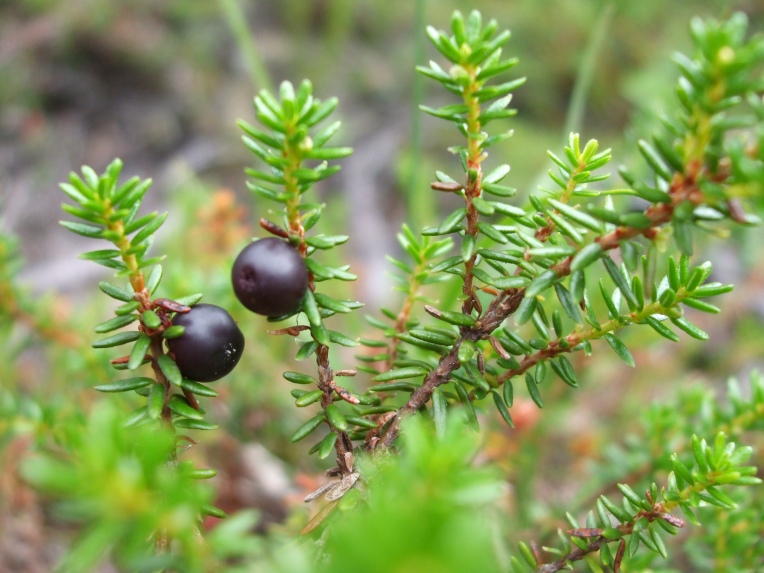
The dwarf evergreens
Dryas integrifolia
The spear shaped leaves of the mountain avens is to me another iconic shape of the tundra. Whether forming into a sharp coniferous tip, or padded out into the more billowy, deciduous-tree form of Dryas octopetala, these OS map symbols of leaves are unrecognisable wherever they grow. But for many, Dryas integrifolia is best known for its flowers – the perfect white circles that polka-dot the tundra floor – and for the twisted filaments that are the phoenix seedhead, catching the sunrays and diffracting light and themselves across the tundra air.


Cassiope tetragona
Growing amongst the rocks and along the dry hillsides, the weeping white bells of Arctic bell heather are another distinctive site at the height of a tundra summer. A relative of the glorious purple heather of the Scottish hills, Cassiope tetragona is similarly small and woody, minute spear-shaped leaves wrapped tight into the stem, forming scaly round limbs. As the season turns, these stems gradually shift from green to orange-brown, giving the tundra an almost burnt look, flowers rusting away to leave the brittle seed heads proud to the wind.
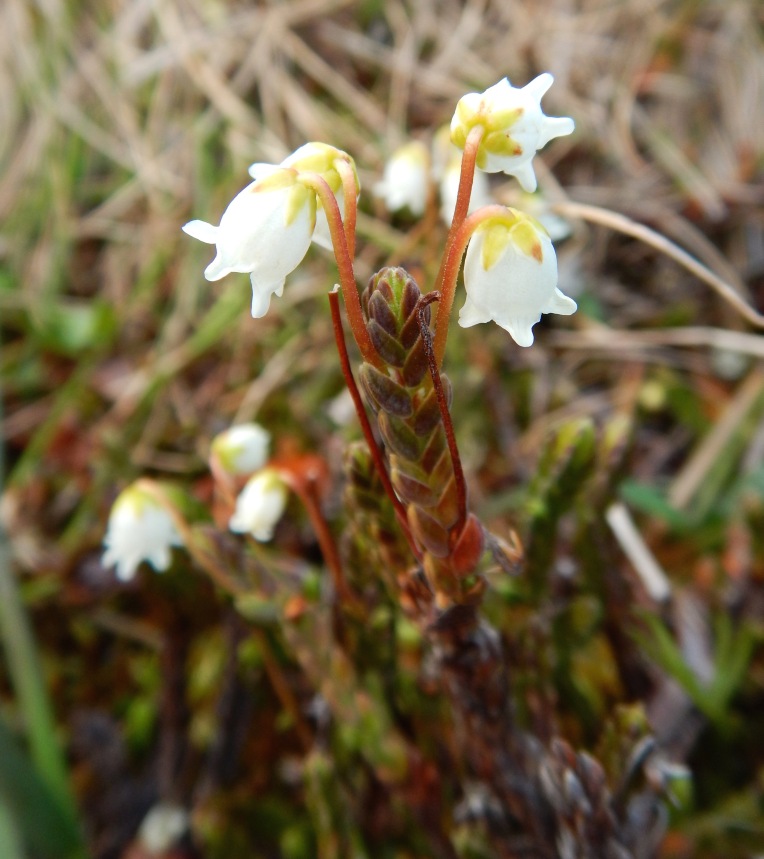
Bonus: The uncategorised
Silene acaulis
If you’ve reached this far, well done for getting to the end. As a special bonus, I’ve included Silene acaulis, better known as moss campion. There is some confusion here as to whether Silene acaulis is best classed as a shrub or a forb. Silene as a genus refers to the campions, delicate flowers of field and rocks, all pink and white and herbaceous green leaves. Yet the harsher climates to which Silene acaulis has adapted produces a hardy, cushion-like shrub, past leaves compressed into woody stems. For myself, I class this bright plant as a forb, yet since I have seen it classed otherwise so under some schemes, it is worth a brief mention here.
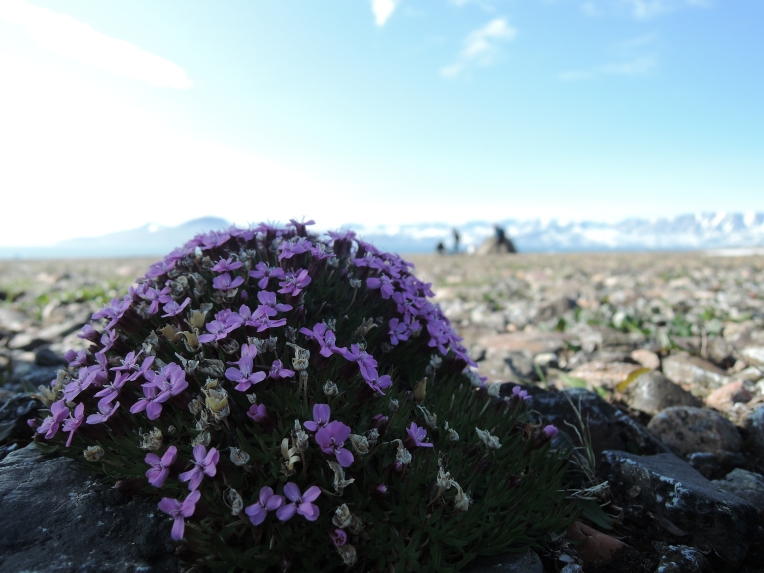
Beyond confusion of classification, Silene acaulis is by no means one to be relegated to the bottom of any list. It grows where often nothing else will, building a bivouac out of its own sharp leaves against the elements. Within this thick shell, the plant can grow to engulf surrounding rocks occasionally supporting other tiny plants as they grow through chinks in its armour. Most spectacular are the pink-purple flowers, which at the height of the summer dot these minuscule mountains like dewdrops, or like pins in a pin-cushion. Silene acaulis is rare on Qikiqtaruk – the soft, undulating landscape means there are few surfaces too harsh for competitors. But I have seen one once, in passing, making a mental note to come back to sample it later. I have never found one since.
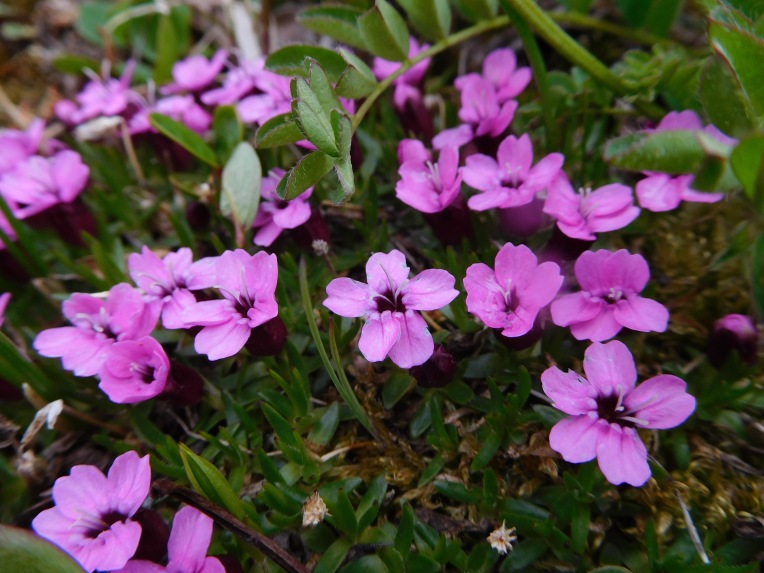
By Haydn, Sandra and Isla



